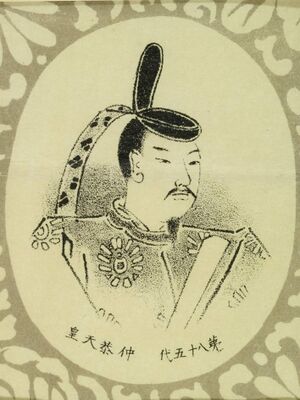الإمبراطور تشوكيو
| Emperor Chūkyō 仲恭天皇 | |||||
|---|---|---|---|---|---|
 | |||||
| Emperor of Japan | |||||
| العهد | May 13, 1221 – July 29, 1221 | ||||
| سبقه | Juntoku | ||||
| تبعه | Go-Horikawa | ||||
| وُلِد | October 30, 1218 | ||||
| توفي | يونيو 18, 1234 (aged 15) | ||||
| المدفن | Kujō no Misasagi (九條陵) (Kyoto) | ||||
| |||||
| البيت | Yamato | ||||
| الأب | Emperor Juntoku | ||||
| الأم | Fujiwara no Ritsushi | ||||
Emperor Chūkyō (仲恭天皇, Chūkyō-tennō) (October 30, 1218 – June 18, 1234) was the 85th emperor of Japan, according to the traditional order of succession. His reign spanned only two months in 1221, and he was not officially listed amongst the emperors until 1870 because of doubts caused by the length of his reign.[1] The Imperial Household Agency recognizes Kujō no misasagi (九條陵) near Tōfuku-ji in Fushimi-ku, Kyoto as his tomb.
Genealogy
Before his ascension to the Chrysanthemum Throne, his personal name (his imina)[2] was Kanenari-shinnō (懐成親王).[3]
He was the first son of Emperor Juntoku. His mother was Ritsushi (?) (立子), daughter of Kujō Yoshitsune (九条良経).
- Consort: Ukyonodaibu-no-Tsubone (右京大夫局), Priest’s daughter
- First Daughter: Imperial Princess Yoshiko (義子内親王) later Wademon’in (和徳門院, 1234 - 1289)
Events of Chūkyō's life
Chūkyō was enthroned at the age of two following the deposition of his father, the Emperor Juntoku in preparation for the Jōkyū Incident, an unsuccessful attempt by Juntoku's father, the Retired Emperor Go-Toba, to overthrow the Kamakura Bakufu.
- 1221 (Jōkyū 3, 20th day of the 4th month): In the 11th year of Juntoku-tennō's reign (順徳天皇十一年), the emperor abdicated; and the succession (‘‘senso’’) was received by his eldest son who was only two years old. Shortly thereafter, Emperor Chūkyō is said to have acceded to the throne (‘‘sokui’’).[4]
That same year, after the Jōkyū Incident, he was dethroned and replaced by his first cousin once removed Emperor Go-Horikawa, the nephew of Emperor Go-Toba.
Because of his dethronement just 2 months after the Jōkyū Incident, his enthronement was not recognized. He was known as the Kujō Dethroned Emperor (Kujō Haitei, 九条廃帝), the Half-Emperor (半帝), and the Later Dethroned Emperor (Go-Haitei, 後廃帝, a reference to Emperor Junnin who was often called Haitei, 廃帝).
In 1870, he was recognized as an Emperor and given the posthumous name of Emperor Chūkyō.[5]
Kugyō
Kugyō (公卿) is a collective term for the very few most powerful men attached to the court of the Emperor of Japan in pre-Meiji eras.
In general, this elite group included only three to four men at a time. These were hereditary courtiers whose experience and background would have brought them to the pinnacle of a life's career. During Chūkyo's reign, this apex of the Daijō-kan included:
Eras of Chūkyō's reign
The year of Chūkyō's reign is more specifically encompassed within a single era name or nengō.[7]
- Jōkyū (1219–1222)
See also
Notes
- ^ Titsingh, Isaac. (1834). Annales des empereurs du Japon, pp. 236–237; Brown, Delmer et al. (1979). Gukanshō, pp. 343–344; Varley, H. Paul. (1980). Jinnō Shōtōki. pp. 223–226.
- ^ Brown, pp. 264; n.b., up until the time of Emperor Jomei, the personal names of the emperors (their imina) were very long and people did not generally use them. The number of characters in each name diminished after Jomei's reign.
- ^ Titsingh, p. 148; Brown, p. 343; Varley, p. 223.
- ^ Titsingh, p. 236; Brown, p.343; Varley, p. 44; n.b., a distinct act of senso is unrecognized prior to Emperor Tenji; and all sovereigns except Jitō, Yōzei, Go-Toba, and Fushimi have senso and sokui in the same year until the reign of Emperor Go-Murakami.
- ^ Brown, p. 343-344 n.104.
- ^ أ ب Brown, p. 344.
- ^ Titsingh, p. 236; Brown, p. 343-344.
References
- Brown, Delmer M. and Ichirō Ishida, eds. (1979). [ Jien, c. 1220], Gukanshō (The Future and the Past, a translation and study of the Gukanshō, an interpretative history of Japan written in 1219). Berkeley: University of California Press. ISBN 0-520-03460-0
- Ponsonby-Fane, Richard Arthur Brabazon. (1959). The Imperial House of Japan. Kyoto: Ponsonby Memorial Society. OCLC 194887
- Titsingh, Isaac, ed. (1834). [Siyun-sai Rin-siyo/Hayashi Gahō, 1652], Nipon o daï itsi ran; ou, Annales des empereurs du Japon. Paris: Oriental Translation Fund of Great Britain and Ireland.
- Varley, H. Paul , ed. (1980). [ Kitabatake Chikafusa, 1359], Jinnō Shōtōki (A Chronicle of Gods and Sovereigns: Jinnō Shōtōki. New York: Columbia University Press. ISBN 0-231-04940-4
| ألقاب ملكية | ||
|---|---|---|
| سبقه Emperor Juntoku |
Emperors of Japan: Chūkyō 1221 |
تبعه Emperor Go-Horikawa |
